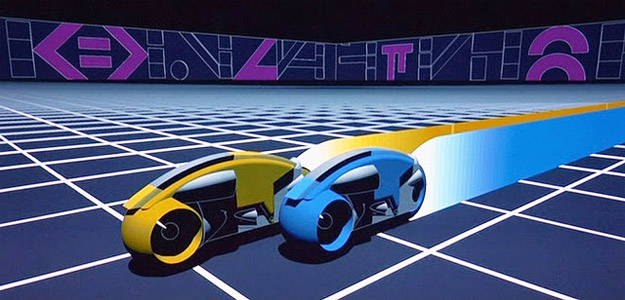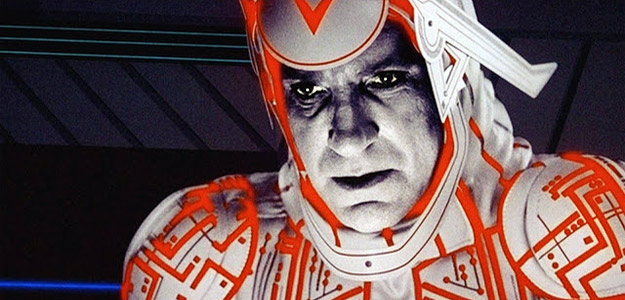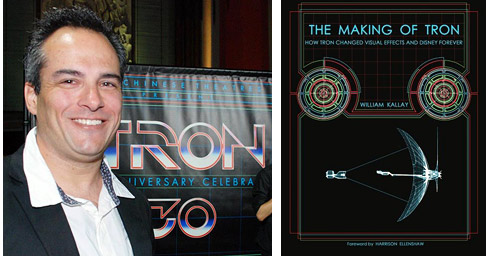THE Q&A
William Kallay is the author of The Making of Tron: How Tron Changed Visual Effects and Disney Forever (2011). He is the co-founder of FromScriptToDVD.com, where he has written about film technology, interviewed filmmakers, and reviewed countless DVDs and Blu-ray Discs. Green Tea, Kallay’s 2004 short film, won the Outstanding Writing Commendation Award from the 48 Hour Film Festival in Los Angeles. He has also written for Go (the official magazine for AirTran Airways) and Widescreen Review.
Michael Coate (The Digital Bits): In what way should Tron be remembered on its 35th anniversary?
William Kallay: Tron should be remembered as a very daring, risky adventure on the part of a few young visionaries and artists. They believed that by using computers for animation and visual effects, they could change moviemaking. There had not been a movie like it before. The characters, or “Programs,” actually lived inside of a computerized world. This film ultimately changed how we see and experience movies, television, and even music videos. Pixar, in my humble opinion, was heavily influenced by John Lasseter seeing the famous Light Cycle sequence in Tron. It is important to note that when Tron was made, the very idea of computers, let alone computerized animation and visual effects, was still extremely new.
Coate: What did you think of Tron? Can you recall your reaction to the first time you saw it?
Kallay: My parents and I lived in Anaheim Hills, a suburb in Orange County, California. At the time, if you wanted to go see a movie, you had the choice of the really small and dingy AMC Orange Mall 6, or the very classy Cinedome in Orange. Cinedome was truly cool because it had dome theaters with giant curved screens, stadium seating and a lot of 70mm presentations, all for a very reasonable admission price.
Video games were totally my world in my late teens. I spent countless hours on my Atari 2600. The graphics were crude, and don’t even get me started on the home version of Pac-Man. Yet being a lonely teenage kid, video games were an escape for me. The arcade was the one place where I found my identity and could actually “be cool” because I was a good video game player.
When Tron opened, I was intrigued. A video game movie? I was also a Disney buff and I knew this movie was something completely revolutionary from them. Bear in mind that Disney of 1982 was much different from Disney today. Tron was a huge risk for the studio. They were not seen as a hip studio and most of the movies they made were cookie cutter Disney family films.
My parents drove with me down to Cinedome on a hot July day. My dad gave me my allowance of a princely $15.00. My parents went to another theater in the complex to see, no kidding, The Best Little Whorehouse in Texas, and I went to see Tron in 70mm Six-Track Dolby Stereo.
Sitting in the rocking theater seat inside the big dome, the curtains parted and Buena Vista Distribution in computerized-looking letters appeared. This was something different from Disney. Suddenly, and very loudly, Tron formed on the screen and the Tron logo flew onto the screen and I was immersed into that opening Light Cycle sequence. I was hooked!
Then the plot started to unfold. There was quite a bit of computer talk and words. There was talk between the old way of computers to the new way of computers. I wanted to see more Light Cycles. Where’s Jeff Bridges? What the heck is ROM and RAM memory? Why do I not understand this computer lingo? Why am I drawn to these spectacular visuals unfolding before my eyes?
Tron ended just as my parents came out of their movie. My dad asked, “How was Tron?” I stood there and said, “I’m not sure. It was cool, but I was confused.” The film made an impact on me, but I was not sure what to make of it. There was something extra special about this film to me and I was unable to articulate its impact on me.
A side note, later that year, my buddy and I rented Tron on VHS. I remember telling him about a hilarious joke with Sark (played by David Warner) on a giant map. Wait for it. Wait for it.... “Where’s Pac-Man!?” I yelled. That was probably my first lesson in aspect ratios and how the ingenious gag of Pac-Mac was cut out of the frame for home video.
Coate: In what way is Tron significant?
Kallay: Tron opened the doors for filmmakers to create films in a digital landscape. Animation and visual effects were largely done by human hands and very expensive tools like the Multiplane Camera (Disney), VistaVision cameras (used by ILM for years), plastic models, stop-motion characters (think of the original King Kong), and cel animation. The makers of Tron felt that using computers would offer more freedom from manually building models, painting fantastic landscapes or animating by hand. Working in the digital world could eventually create animation and visual effects that were never possible before.
It is also one of the most visually stunning films I have ever seen. The artistic brainpower behind Tron was incredible: Syd Mead, Jean “Moebius” Giraud, John Norton, Harrison Ellenshaw, Richard W. Taylor II, and many others.
Coate: Why do you think Tron was unsuccessful in its original release?
Kallay: Tron made around $33 million (roughly $84 million today) in its original release, which for the time was decent. It just did not make the kind of money that some of the higher profile releases like E.T. and Star Trek: The Wrath of Khan did. The summer of 1982 was an amazingly strong period for film, both critically and economically. There were scary films like Poltergeist and The Thing. Blade Runner, though in its original release, was a considered a box office disappointment. It was eventually seen as a classic. Rocky III made a ton of money and looked like it might be the year’s biggest hit until E.T. came to Earth. Tron had a lot of competition.
One would think that Tron would have cleaned up at the box office because it was a movie about video games. The film had a big star in Jeff Bridges. Bruce Boxleitner was well known as a television actor. Cindy Morgan was Lacey Underall in Caddyshack (1980) for heaven’s sake! David Warner was hot after starring in the cult hit, Time Bandits (1981). The film had groundbreaking computer animation and visual effects. There was an arcade video game tie-in in arcades across the country. Kids and teens lined up to play the game. The film had a stellar line up of visual effects geniuses and designers.
The film fell short at the box office for a few reasons, in my opinion. Not everyone back in 1982 was versed in, or even used, computers. Disney had to fight for theaters to show the film. It was a huge summer for 70mm prints and many of the early summer movies with those prints were still playing in big auditoriums. Audiences that summer were into emotional movies like E.T., Star Trek: The Wrath of Khan and Rocky III, whereas Tron initially comes off cold. As a teenage video game guru back then, I wanted to see more video game action, though I now love the story concepts that Tron presents.
The crazy thing is that Tron eventually made money on the original arcade game, the home video release, the home video game, DVDs and Blu-rays, and nostalgia. In 1999, Disney struck a new 70mm print and it has been in circulation ever since in revival theaters (though I am not sure if Disney has re-struck a new print since then). New audiences discovered Tron on the big movie screen where it is meant to be seen. Disney approved a sequel, a cartoon series, and the Tron Light Cycle Power Run roller coaster in Shanghai has been a hugely popular attraction. I am no math wizard, but the Tron property has feasibly made nearly $1 billion for Disney by now. Not bad for a box office “flop.”

Coate: In what way was it beneficial for Tron to have been photographed and, in some theaters, presented in the 70mm format?
Kallay: Technology of merging live actors like Jeff Bridges, Bruce Boxleitner, Cindy Morgan, David Warner and Dan Shor into a computerized environment did not exist in 1981 when Tron was filmed. The great visual effects artists and animation gurus needed to “fake” the actors in the Electronic World. It has been awhile since I have gone over my book and notes, but I believe that director Steven Lisberger and cinematographer Bruce Logan, ASC ultimately decided to shoot Tron in 65mm due to the need to blow up each Electronic World frame to Kodaliths (large film cels). They could maintain high picture quality that way.
If they had shot the film in 35mm, the Kodaliths would have had tons of large film grain throughout the picture. Disney balked at the slightly extra expense of shooting in 65mm, but they finally realized going this route was the smart decision. Using Kodaliths was the only way in which to make the live action “computerized.”
When Tron was released in theaters, 70mm had been undergoing a revival. That summer of 1982, which is regarded by film fans as one of the greatest ever, had a huge number of 70mm blow-up prints struck for theatrical exhibition. Tron just so happened to be filmed in 65mm and some VistaVision.
Coate: Do you think the Academy was justified in not nominating Tron in the category of Best Visual Effects?
Kallay: Absolutely not. The Academy voters were in love with E.T. That year there was Poltergeist and Blade Runner in the mix for an Oscar nomination for Best Visual Effects. Tron should have been included in that very honorable group of films. Not that I am against E.T., but Tron was truly a groundbreaker. To this day, my good friend Richard W. Taylor II (co-visual effects supervisor of Tron) still thinks he and his amazing crew were robbed. I agree.
The mindset of visual effects artists, especially back then, was not into using computers. Computers were very rarely used for film work. Computers were the devil’s work. Effects should not be automated! The idea that a computer would do “almost all of the work” in visual effects was scary, though we now know that computers need people. It took several years, but computer animation and visual effects are used by hundreds of artists on one film today. Tron only had a few computer animators and they were divided by four different outside companies.
Coate: In what way was Steven Lisberger an ideal choice to direct Tron and where does the film rank among his body of work?
Kallay: Tron was Steven’s creation when he opened a studio in Venice Beach, California. He was the ideal choice to bring his vision to the big screen. His studio was a showcase for some of the most amazingly brilliant artists to come from the early 80s. There are some disagreements among some of the artists I interviewed on the creation of Tron, but Steven’s influence and vision is truly spread across this film. This was not an easy sell to the major studios back then. Steven is very persuasive and knows his vision.
Steven did an exceptional job on Tron. He did not have any feature film experience except for Animalympics (1980). Tron was a huge undertaking with new computer technology, a big movie star like Jeff Bridges, and an eclectic crew of super artists like Bill Kroyer, Jerry Rees and Darrell Rooney. Did I, as a fan and viewer, have some issues with the storyline? Sure. Yet in hindsight, there are some very intriguing ideas that I delve into in my book.
I have always wanted to see more films from Steven because I truly believe he is incredibly talented and a great guy. In my opinion, Tron is Steven’s best work. It has stood the test of time and he should be proud of his work. He did a couple of features soon after Tron. There was Hot Pursuit (1987) and then Slipstream (1989). I watched Hot Pursuit and felt it did not have the same vision and “guts” that Tron had, but John Cusack helped make the film enjoyable. I once found a DVD of Slipstream at a store and regrettably did not buy it. So I cannot judge Steven’s work on that film.






